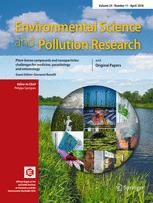Ver ítem
- xmlui.general.dspace_homeCentros Regionales y EEAsCentro Regional Buenos Aires SurEEA BalcarceArtículos científicosxmlui.ArtifactBrowser.ItemViewer.trail
- Inicio
- Centros Regionales y EEAs
- Centro Regional Buenos Aires Sur
- EEA Balcarce
- Artículos científicos
- Ver ítem
Non-point source pollution of glyphosate and AMPA in a rural basin from the southeast Pampas, Argentina
Resumen
We measured the occurrence and seasonal variations of glyphosate and its metabolite, aminomethylphosphonic acid (AMPA), in different environmental compartments within the limits of an agricultural basin. This topic is of high relevance since glyphosate is the most applied pesticide in agricultural systems worldwide. We were able to quantify the seasonal variations of glyphosate that result mainly from endo-drift inputs, that is, from direct spraying
[ver mas...]
We measured the occurrence and seasonal variations of glyphosate and its metabolite, aminomethylphosphonic acid (AMPA), in different environmental compartments within the limits of an agricultural basin. This topic is of high relevance since glyphosate is the most applied pesticide in agricultural systems worldwide. We were able to quantify the seasonal variations of glyphosate that result mainly from endo-drift inputs, that is, from direct spraying either onto genetically modified (GM) crops (i.e., soybean and maize) or onto weeds in no-till practices. We found that both glyphosate and AMPA accumulate in soil, but the metabolite accumulates to a greater extent due to its higher persistence. Knowing that glyphosate and AMPA were present in soils (> 93% of detection for both compounds), we aimed to study the dispersion to other environmental compartments (surface water, stream sediments, and groundwater), in order to establish the degree of non-point source pollution. Also, we assessed the relationship between the water-table depth and glyphosate and AMPA levels in groundwater. All of the studied compartments had variable levels of glyphosate and AMPA. The highest frequency of detections was found in the stream sediments samples (glyphosate 95%, AMPA 100%), followed by surface water (glyphosate 28%, AMPA 50%) and then groundwater (glyphosate 24%, AMPA 33%). Despite glyphosate being considered a molecule with low vertical mobility in soils, we found that its detection in groundwater was strongly associated with the month where glyphosate concentration in soil was the highest. However, we did not find a direct relation between groundwater table depth and glyphosate or AMPA detections. This is the first simultaneous study of glyphosate and AMPA seasonal variations in soil, groundwater, surface water, and sediments within a rural basin.
[Cerrar]

Autor
Fuente
Environmental Science and Pollution Research 25 (15) : 15120-15132 (May 2018)
Fecha
2018-03
ISSN
0944-1344
1614-7499
1614-7499
Formato
pdf
Tipo de documento
artículo
Palabras Claves
Derechos de acceso
Restringido
 Excepto donde se diga explicitamente, este item se publica bajo la siguiente descripción: Creative Commons Attribution-NonCommercial-ShareAlike 2.5 Unported (CC BY-NC-SA 2.5)
Excepto donde se diga explicitamente, este item se publica bajo la siguiente descripción: Creative Commons Attribution-NonCommercial-ShareAlike 2.5 Unported (CC BY-NC-SA 2.5)

